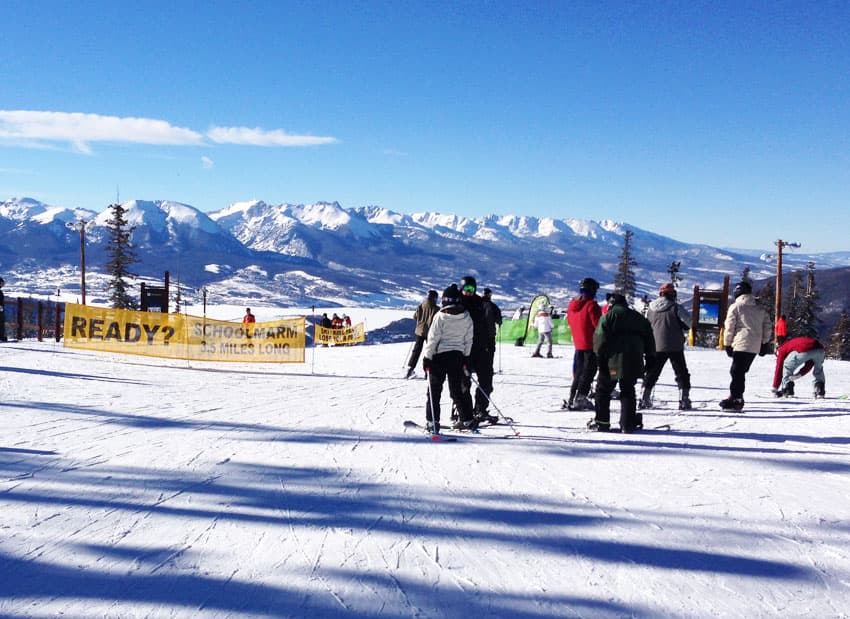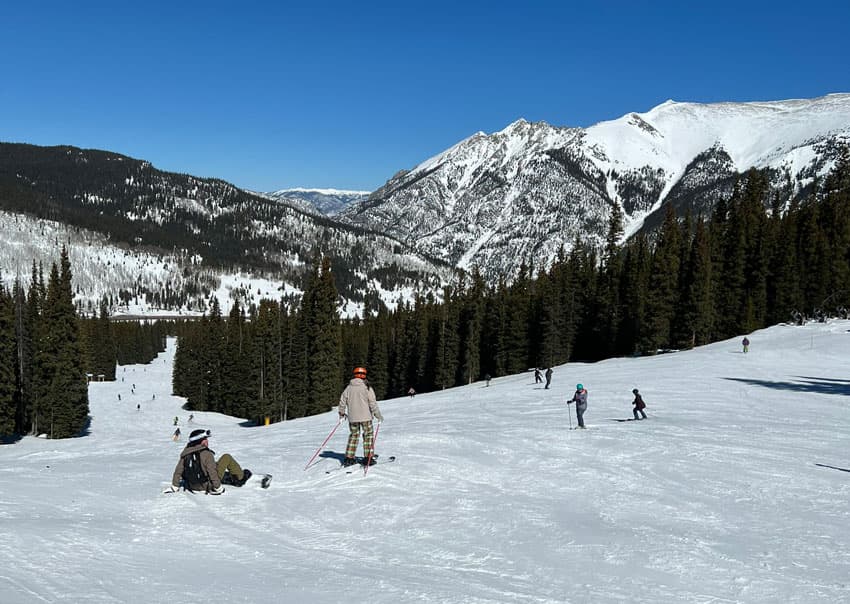It was only day two or three on skis when I crashed into my brother’s friend on a green trail at Elk Mountain, Pa. Please don’t blame a snowboarder – the snowboard hadn’t even been invented yet.
He was standing on the side of the trail looking up at me. I was headed downhill, fully aware that I needed to turn. I did know how to turn, but as a very green skier, I just couldn’t and flew right into him. Luckily, neither of us were really hurt. And we didn’t even have helmets.
But avoiding collisions is the responsibility of the uphill skier, you say? And you would be right. That crash was my fault. But that didn’t help my brother’s friend.
Just because a skier or snowboarder is uphill and responsible for avoiding a collision downhill doesn’t mean there won’t be a collision. It doesn’t even mean the guilty party will ever accept responsibility or be punished in the event of a collision.
Since I’d rather avoid a collision, whether it’s with a skier or snowboarder, than proclaim my rightness and knowledge of the skier’s responsibility code from a hospital bed, I make sure to pay careful attention to the following tips:
Avoid Crowds on the Slopes
It’s hard to collide with someone if there’s nobody else on the trail. This means avoid weekends and holidays and ski midweek.

I know, you work midweek. American workers average 25 paid vacation, sick, and personal days per year. Plan to allocate 10 of them for midweek skiing. You won’t regret it.
If you insist on skiing on a weekend or holiday, figure out which parts of the mountain get the most and the least traffic. On a trip to Heavenly, we spent a day ripping blue cruisers under the Galaxy lift while gazillions of other people fought over every square inch of the same kind of blue terrain at the nearby Dipper Express. The Galaxy lift was brutally slow and didn’t have a footrest, and that’s why we were the only ones skiing that area, but it was worth it to avoid everyone else.
You’re Not Alone on the Ski Trail
Even if you took a sick day midweek and think you’re alone on the trail, there’s probably someone behind you going too fast or someone downhill sitting in the middle of the trail under a lip.
If you like to make dramatic, 30-meter radius GS turns back and forth across the entire trail, at least look uphill over your shoulder at every turn. Someone even smoother might’ve caught up to you from behind.
Sure, anyone behind you needs to look out for people ahead carving such sweet crescent turns, but know that going across the slope can invite disaster and be sure to look downhill, look around, and look uphill to prevent a collision.
Be Aware of Your Surroundings to Avoid Skiing Injuries
Looking uphill for oncoming danger isn’t just for people carving wide turns. It’s important to look uphill every time you’re about to merge from one slope into another. And beware that in these situations, the uphill skier probably cannot see you merging in from the other trail.
It’s ok to wave your arms or poles to be seen. Even though you may technically be the downhill skier, your decision to slow down and check uphill may be the reason you avoid a collision with someone enjoying the softer snow at the edge of the trail.
In fact, it’s important to look uphill, behind you, or over your shoulder every time you’re about to start moving. Even when you’re done adjusting the bindings at the top of the lift, take a look behind you before you go. There’s probably someone who just got off the lift who’s going around you complaining about why you stopped where you did.
If you need to stop to take a break, don’t park yourself where you cannot be easily seen from uphill, like under a lip, around a curve, behind a lift tower, or – my favorite – under a jump or terrain park feature.

If I need to stop to look at a trail map, check my gear, or regroup to be sure everyone is still together, I try to stop at or behind a bright orange “slow” sign. They’re easily seen from uphill and everyone naturally goes around them.
As you approach the bottom of the hill where the trails spill out at the base area, slow down and look left and right and all around, and keep doing that. You need to avoid the frenzy of people of all abilities moving at very different speeds across the hill in every direction.
Unfortunately, most base area designs require people to get extra speed here if they’re going into the lodge or trying to get to a faraway lift. It’s especially tough for snowboarders since it’s that much harder to skate in a flat area.
At the same time, don’t stand at the front of the lift corral blocking the lane while looking uphill for your friends because you’re just so damn fast. Many of us don’t want to stop at the corral, and since we’re skiing when it’s not crowded, we’re going to ski right onto the chair without stopping.
If you’re in the way, you’re creating a chance for a collision. Just stand off to the side. And stay alert for people who can’t stop or turn very well. Someone’s usually getting tangled up in the corral and you need to avoid getting entangled in that potential injury. Weird, twisting types of falls can cause serious injuries even without the high speeds.
It’s the Snowboard
Can you believe you’ve read this far about avoiding collisions while skiing and not once have I blamed snowboarders? I suspect there are just as many self-centered and inconsiderate skiers as there are snowboarders, though snowboarders get more of the hate.
However, if you’re trying to avoid a collision, then it’s important to be objective and understand that the snowboard creates a different field of vision for snowboarders than skis do for skiers.
Skiers typically face forward and are able to see the entire slope in front of them, if they bother to look. Snowboarders typically point their shoulder down the hill and face the side of the trail or the woods with their backs to the other half of the trail. Their field of vision is different. They just can’t see what’s behind them when turning backside, and, unfortunately, what’s behind them is often someone else.
If you’re the snowboarder who can’t easily see what’s behind you, then try to be a little more aware before turning blindly. If you’re the someone else, then be aware the snowboarder probably just doesn’t know you’re there, and can’t hear you with the music so loud.
Despite this exhortation, I don’t expect anyone on the mountain to be trying any harder to look around and be courteous and considerate. Rather, I ski as if the snowboarder cannot see me, doesn’t know I’m there, and is about to turn into my lane at any second. I may yell a friendly alert like “Behind you on your left!” as I ski behind the blind side and put some distance between us.
Try to look ahead and anticipate how the other person may move. And be on the lookout for people suddenly appearing out of the woods and onto the trail. They usually can’t see the people already on the trail and they usually cannot be seen until it’s too late. It’s ok to yell and wave to be seen and help avoid a nasty collision.
The same issue for side hits. Be aware that people like to do jumps and tricks off bumps and ridges that form on the sides of trails. Since they’re often on the sides of blue trails, better skiers and riders consider these easy pickens and don’t pay close attention to the landing or to whether someone else might be in the way. Learn to recognize the side hits before you ski into the landing areas and stay away.
How to Be Seen on the Ski Slopes
It’s hard for people to avoid crashing into you if they can’t see you. Have you noticed there are very few all white ski suits? Wear bright clothing whenever possible. It doesn’t have to be vintage magenta from the 80s, but it’s important that your colorful gear captures attention from people even in their peripheral vision.
It gets even more difficult to be seen when it’s snowing or foggy so think about red, orange, yellow, and striking patterns like tiger stripes. I’m guilty of wearing a lot of blue and black so I put orange reflective emergency tape on my black helmet.
Become a Better Skier or Snowboarder
I’m not one to berate an improving skier from trying a trail that’s probably beyond his or her ability. That’s how you get better and how you figure out the areas that need work. Then you go back to the easier trail and practice. The better you become as a skier or snowboarder, the more quickly you can react to a sudden obstacle, like a person, and the more easily you can avoid a dangerous collision.
Plus, as you improve, the random, awkward falls and silly mistakes disappear, your skiing and riding become more consistent and predictable, and you become less of a danger to everyone.
Skiing better equals a lower chance of skiing injuries. So get out there are enjoy the slopes – but always stay aware!

Leave a Reply